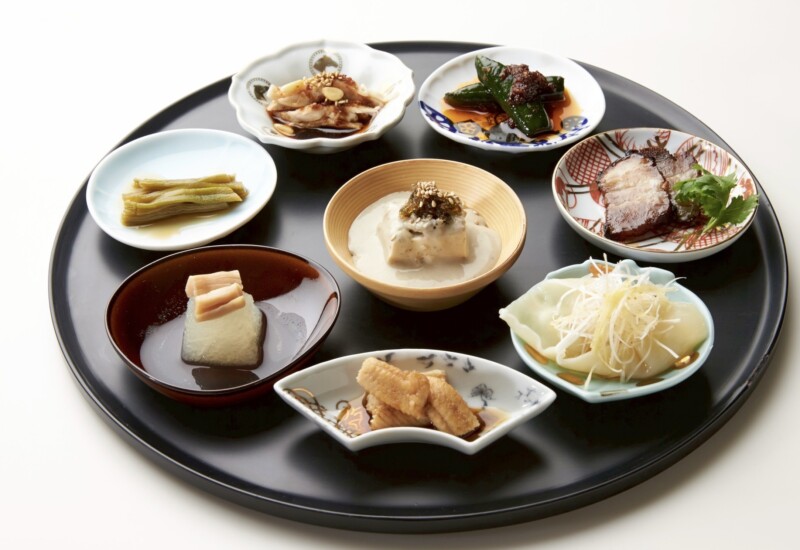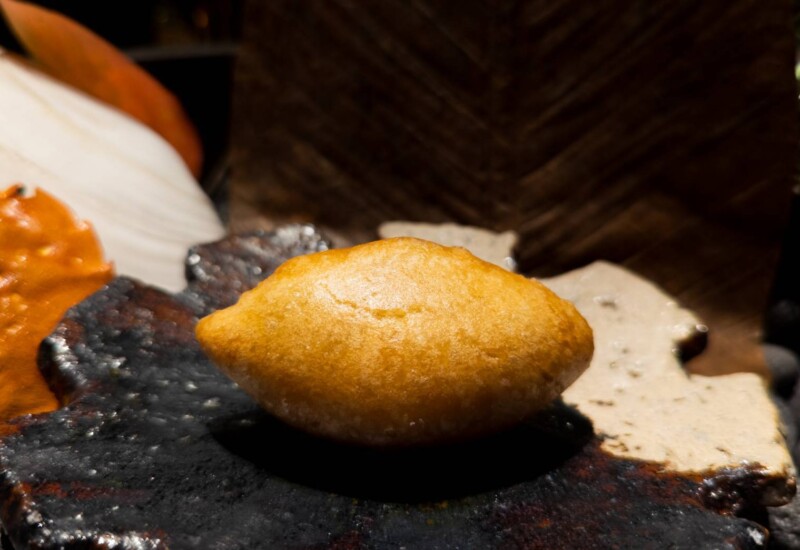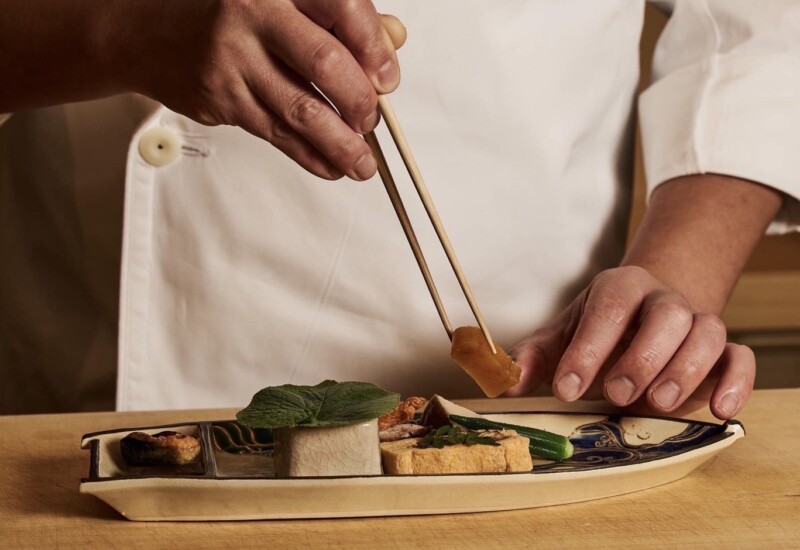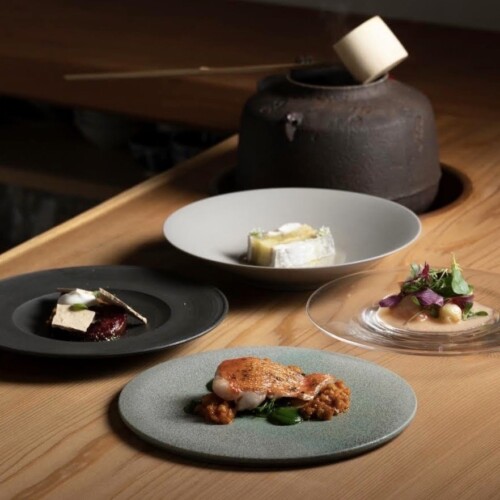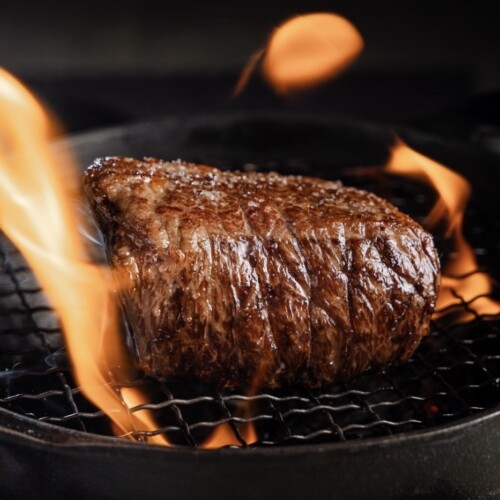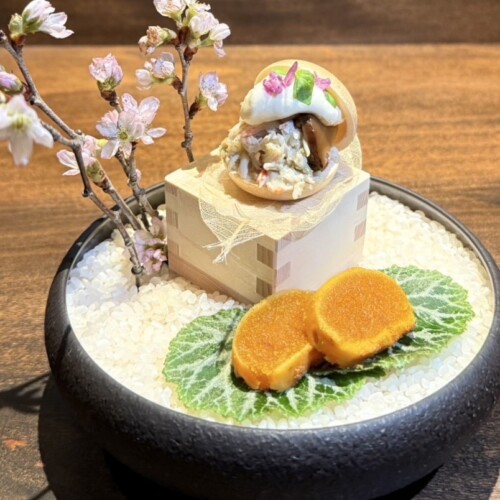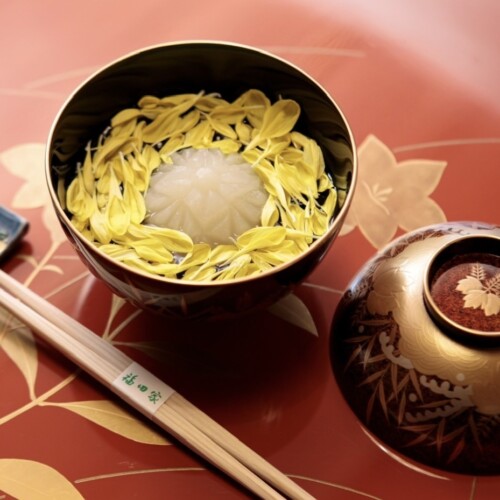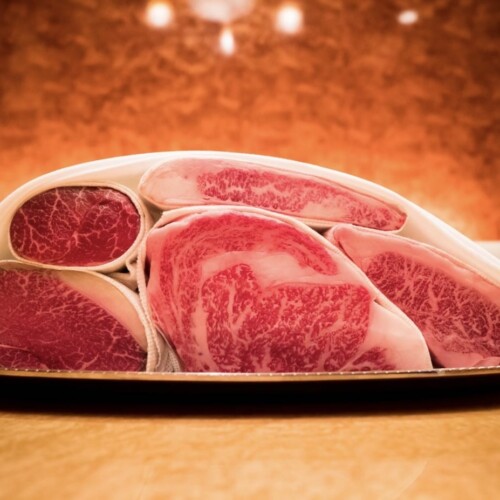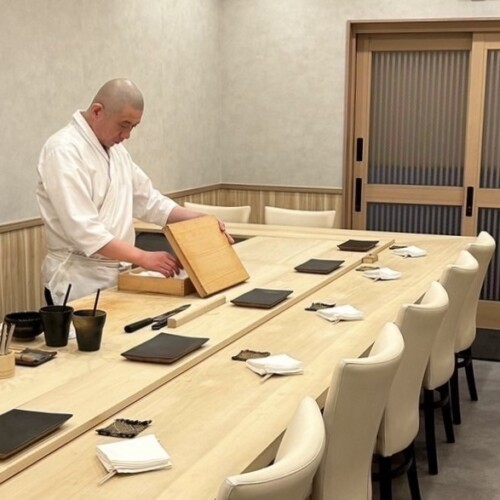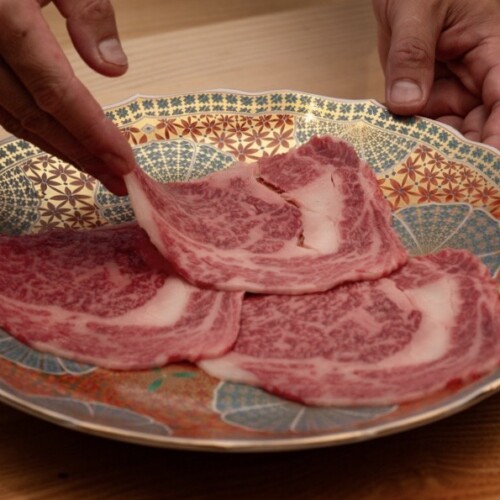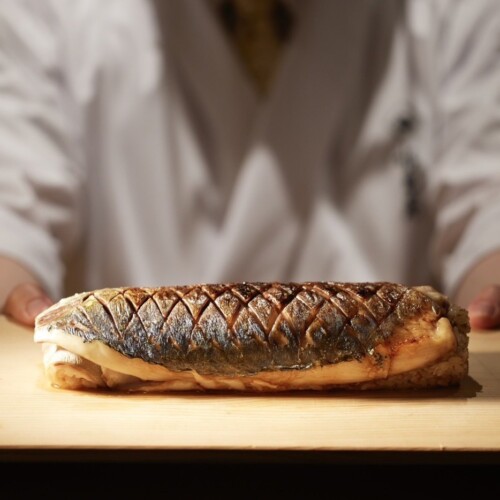熟成鮨 万 / Jukusei Sushi Yorozu

①Please introduce your restaurant.
My name is Akira Shirayama, the owner of Jukusei Sushi Yorozu in Shibuya.
We operate a sushi restaurant that centers around aged sushi—featuring fish that has been carefully matured to enhance its flavor and texture.

②What values or principles are most important to you as a restaurant?
While many people may think of sushi as a dish for enjoying fish, to me, sushi is ultimately about the rice. That’s how I approach making it.
Because of that, I put a lot of thought into how we handle the rice. In fact, we produce our own original rice variety called “Yorozumai” in Nagano Prefecture.
We use red vinegar that’s been fermented over nearly 20 years to season our rice, and our sushi concept is built on the idea of letting guests truly experience the depth and character of that rice.

③ How do you select your ingredients, and what do you prioritize when sourcing them?
At our restaurant, over 90% of the fish we use does not come from the Toyosu Market.
Instead, we source fish that suit Yorozu directly from local markets, ports, and fisherman friends around Japan.
These fish are carefully handled using techniques such as blood draining, ikejime, and precise temperature control, all adjusted to match the season.
From there, I decide how to approach each fish—bringing out its character through the best method suited to it.

④ What makes your restaurant unique compared to others?
Our original rice, called “Yorozumai,” is based on the Koshihikari variety.
It’s grown in the rural town of Tōmi, Nagano Prefecture, at an elevation of about 750 meters.
Compared to standard Koshihikari, it has very little stickiness, but in exchange, it’s packed with Koshihikari’s distinctive umami.
We let the rice rest for nearly a year with the husk still on to allow for natural dehydration.
After threshing, we send the brown rice to a trusted rice vendor, who polishes it into two grades: fully polished and 80% polished.
These are then delivered to us once or twice a week, ensuring we always work with fresh rice at its peak condition.
⑤Do you have any particular approach or philosophy when it comes to plating and presentation?
When salting fish, I use salt from the Guérande salt flats in France, which comes in a range of grain sizes—powder, fine, medium, coarse, and extra coarse.
I select the grain size depending on the size of the fish, its fat content, and how much moisture I want to draw out—and how quickly.
The reason I use only Guérande salt is because switching between different types of salt can cause inconsistencies in flavor and texture.
By adjusting only the grain size, I can control how moisture is drawn out—slowly, while leaving some natural character intact.
It’s about removing moisture without over-drying, and creating subtle shifts based on the fish and the result I want.
There are many detailed techniques involved, but one example is dehydration using salt.
Some methods involve a firm salt cure, while others rely on air-drying without using any salt at all.
When it comes to aging, we use six different types of wrapping paper.
We change the type of paper depending on the condition and cut of the fish to fine-tune the aging process.
We combine these variables to adapt the aging method to each individual piece of fish, ensuring the result is unique and optimized every time.

⑥ How do you curate your selection of alcoholic beverages?
To be honest, I can’t drink alcohol at all. But I do have a strong sense of taste, so I personally taste and select every drink we serve, carefully curating them to pair with the dishes I want to present.
One of my guiding principles is to avoid serving well-known sake from mass-market breweries.
I mainly use sake from smaller, lesser-known brewers—types that are rarely, if ever, found on the general market in Japan.
Beyond sake, we also offer unique drinks like a house-made chuhai fermented with our own koji, as well as original bourbon whiskey that we age ourselves in Mishima, Shizuoka.
One particular sake I offer is completely unavailable in Japan. It’s made by master brewer Yoshiki Yukimachi at Takeno Shuzo in Kyotango, Kyoto.
The brewery uses spring water from Mount Hongo-Tozan, which rises directly beneath the facility. With that water, they craft sake using completely different techniques, tools, and methods from conventional brewing.
When people first taste this sake, they often think it’s sweet—but in terms of sugar content, it actually contains very little.
Its sugar level is roughly the same as, or even slightly lower than, regular sake.
It’s brewed to have a molecular structure similar to human body fluids, which creates a smooth mouthfeel and elegant aroma. There are currently 13 distinct varieties, all shaped by unique koji characteristics. This is the only sake I, someone who can’t drink, am actually able to enjoy.
They’re incredibly delicious, so I always keep all 13 varieties stocked and ready to be shared with guests.

Let me explain two especially distinctive sakes from that collection. One is called Ido (meaning “well”), which symbolically represents the inner self—our emotions and psychological depth.
Building on Ido, they added nigari (bittern) using the same brewing technique to create Ego—a sake that explores how human ego can influence the behavior of koji.
It was an experimental sake—designed to observe how koji reacts when minerals are added to Ido.
I refer to them a sister sakes. Together, Ido and Ego represent the duality of human nature.
Each bottle is filled with intention and a story. If you’re interested, feel free to ask me at the restaurant—I’d be happy to share more in depth.
Among these are Ido, Ego, and another one called Eco.
Their labels are printed using watermark techniques similar to banknotes. When you photograph them with flash versus without, the design changes—it’s a special, interactive feature.
Each bottle is also custom made. From the bottle to the label, every detail reflects deep craftsmanship and dedication.
The first time I tried it, I just took a tiny sip since I usually can’t drink. But even that was enough—I actually wanted to drink more. I was with the brewer at the time, and we talked in depth about the experience while tasting the sake together.
I realized then—this guy is wonderfully unconventional. And that’s why his sake resonates with me so well. We became close, and now we regularly stay in touch. We’ve even traveled overseas together and collaborated on events, usually once or twice a year in Kyoto or elsewhere. He’s a brewer I deeply trust, and his sake is something I proudly serve.


This is our original whiskey, which we’re aging in Mishima, Shizuoka.
It’s not finished yet—it’s still aging in barrels, and the final product will be ready in three years.
From selecting raw ingredients to the base spirit and barrel type, we taste-tested everything in detail to create this bourbon-style whiskey.
The goal is to make a whiskey that pairs perfectly with sushi. For now, we serve only samples of the aging whiskey in progress.
Even in its current form, whiskey lovers find it delicious—they often come back for multiple pours.
The final product won’t be made available to the public. It’s exclusive to those who purchase barrel ownership. This version will be complete after three years.
We’re also aging another version that will take ten years to complete.
The one currently available has been aging for nine months. The alcohol is still a bit sharp, so it’s best enjoyed diluted in a highball or slowly over ice.
Once it’s fully aged, it will be smooth enough to enjoy straight over ice—and dangerously easy to drink. If you visit, please try it under the name “Yorozu.”

⑦ Can you tell us about your attention to interior design, tableware, and the overall dining atmosphere?
The interior design is based on a black color scheme, with all other elements expressed primarily through natural wood. That was the foundation of the design concept.
Each light can be individually adjusted, allowing us to fine-tune the lighting throughout service. We subtly shift the lighting according to how guests progress through their meal.
In recent years, it’s become increasingly difficult to convey seasonality through fish alone.
That’s why we incorporate seasonal touches through other means—like the type of wood used for the chopsticks or the design of the coaster at each guest’s seat.
We put great care into these subtle details so that guests can still feel the seasons throughout their dining experience.
As for our tableware, we use many original pieces created by artisans specifically for our restaurant.

One example is a wasabi dish we serve at the very beginning of the meal. It was created by Mr. Tomita, an artisan I met by chance through my wife, who happened to be classmates with his wife.
His work is characterized by a unique technique—pouring real gold onto the surface and revealing an ichimatsu (checkered) pattern beneath. It’s a concept that really defines his artistic style.
I asked him to create a dish specifically sized for serving wasabi, and he crafted one perfectly suited to that purpose.
When we serve it to guests, their first response is usually something like “How cute!” or “How cool!” It’s an incredibly stylish and one-of-a-kind piece.

⑧ What inspired you to become a chef?
At first, my only thought was, “If I become a sushi chef, I’ll be able to eat sushi every day.”
I had actually been seriously pursuing a career as a professional tennis player.
At the time, I met a now-famous tennis player—he wasn’t a pro yet, just a junior—but I was overwhelmed by the difference in level.
That experience made me realize I couldn’t make a living through tennis, and I gave up on the dream of going pro.
After that, I accepted that men work until the end of their lives—so if I have to work, I want it to be something I love.
So I wrote down a list of all the things I liked, and next to each, the kinds of careers connected to them.
For example, under tennis: player, coach, shop owner, or working for a tennis brand.
Then I added singing—so things like singer, composer, etc. I brainstormed and wrote down all the possible paths.
Since I was still in high school, I also wrote down what each career required—like going to university, moving to Tokyo, or going abroad—and marked whether I actually wanted to do those things.
In the end, two paths remained: childcare worker or chef.
I reflected on who I was at the time and tried to envision where each path would lead.
This was during the early days of the internet—nothing like today with YouTube and endless resources.
Even so, I was able to do some online research and gather enough information.
First, I looked into becoming a childcare worker, but I couldn’t help feeling the future seemed limited and bleak.
Then I looked into being a chef. You can learn while earning a salary, usually have housing, and never worry about food.
Eventually, you can go independent. It’s a skill-based profession, and I felt it would give me full control over my life.
That’s when I decided—I’ll become a chef.
Then I listed out all types of chefs—Western cuisine, Japanese, French, Italian, pastry…
And since I loved rice, it had to be Japanese cuisine.
Within Japanese cuisine, there are many styles—sushi, kaiseki, izakaya, and so on.
I chose sushi because I figured, if I become a sushi chef, I really will get to eat sushi every day.
⑨ What kind of guests would you like to welcome?
If I can be a little selective, I want to serve people who truly love sushi.
Ideally, I’d like to serve people who are genuinely interested in my sushi—who have a curiosity and respect for Japanese food culture.
People who understand and appreciate what Yorozu represents. That’s who I hope to welcome to my counter.

⑩ Are there any rules or things that are not allowed in your restaurant?
One point I always emphasize is scent—especially perfume.
We don’t have a dress code for clothing, but I do enforce what I call a “fragrance dress code.”
In such a small, intimate space like a sushi counter, guests dine side by side.
I ask everyone to be considerate—while I fully understand that perfume is part of some cultures, I kindly request that guests wear little or no fragrance when visiting us.
Smoking is another important issue.
We kindly ask that guests do not step out to smoke, even during the course of their meal.
Like with perfume, smokers may not notice their own scent, but others can.
Scent is a crucial element in sushi—just as important as taste.
To protect that sensory experience for everyone, and to preserve the aromas I’ve carefully crafted, we ask guests to avoid smoking—even during breaks between courses.
⑪Do you have a message you'd like to share with your guests?
Sushi comes in many forms, and every chef has their own way of expressing it.
Even the same type of fish can offer different aromas, textures, and impressions depending on the restaurant.
That diversity—that creative freedom—is one of sushi’s greatest appeals.
Among all those styles, aged sushi is especially unique.
It’s quite different from the sushi most international guests imagine.
If you’re curious and eager to experience something new, I sincerely look forward to welcoming you here.


